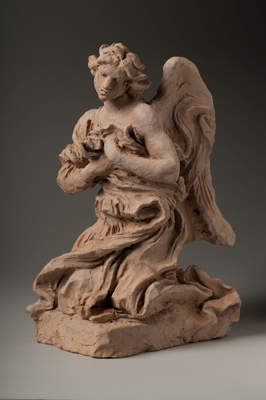On a quiet October afternoon in the Harvard Art Museums, conservator Tony Sigel casually introduced a staff member to some of his favorite objects in the collections. Using the flashlight on his mobile phone, he cast light on a terracotta sculpture by Italian Baroque artist Gian Lorenzo Bernini.
“Look at that fingerprint,” Sigel said, pointing to the impression in the clay forming the shoulder of one of Bernini’s Half-Kneeling Angel models. “You can tell that the clay’s texture was very ice cream-ish, easily moved, when Bernini modeled this part.”
Sigel, a conservator of objects and sculpture in the museums’ Straus Center for Conservation and Technical Studies, researches, examines, and conserves all manner of objects in the museums’ collections. But with a background in terracotta sculpture, he’s always been drawn to the collection of 15 Bernini bozzetti, or “clay sketches.” Sigel has dedicated countless hours to studying the objects. Today he is widely recognized as the world’s foremost expert on Bernini terracottas, having recently co-curated the traveling exhibition Bernini: Sculpting in Clay, shown at the Metropolitan Museum of Art in New York and the Kimbell Art Museum in Fort Worth, Texas.
The Harvard Art Museums hold the world’s single largest permanent collection of Bernini terracottas. Sigel estimates that only about 40 to 50 of them still exist today, though the artist may have created thousands.
“Bernini was extraordinarily productive,” Sigel said. “He began working as a teen and kept at it throughout his life—and he lived to the old age of 81.” The artist’s impact on 17th-century Rome was as profound as his output; he created dazzling sculptures for the city’s Piazza Navona and St. Peter’s Basilica in the Vatican, among other locations. To ensure his prolific production, he employed a vast number of people. “It’s said that anyone who could hold a chisel and swing a hammer worked at Bernini’s studio at one time or another,” Sigel said.
Sigel and other experts believe that Bernini created his terracotta models as quick, preparatory sketches to develop his ideas, and from which he or others could then execute full-scale versions in marble or bronze. The works were small, about due palmi, or “two palms,” high. “They were the step in the process that was most closely connected to Bernini’s hand,” Sigel said.
Because of the terracottas’ temporary uses, they weren’t typically saved; the fragile examples that do survive must have been fired and kept by Bernini’s associates or admirers for particular reasons. We’re lucky that any remain at all, Sigel said.
Sigel delights in pointing out features that provide insight into the terracottas’ creation: for instance, tiny marks and holes in some works that show where measurements were taken, or fingernail pinches at the back of the neck of some figures, one of Bernini’s signature techniques, according to Sigel.
“You can see Bernini’s ideas changing and developing from model to model,” Sigel said. “It’s as if we were standing behind him looking over his shoulder as he worked.”
“In many ways, the museums’ Bernini terracotta collection has functioned as a Rosetta Stone,” said Stephan Wolohojian, the Landon and Lavinia Clay Curator of European and American Art. With the vast knowledge Sigel and others have gathered from close study of the objects, “our collection can be used as a basis for comparison” with others, in addition to shedding light on Bernini’s life and work as a whole.
The terracottas also serve as ambassadors to one of the most striking aspects of the museums’ new architecture, the Winter Gardens. These intimate, glass-walled galleries on opposite ends of Level 2 offer the feeling of being at once inside and outside, with views of the surrounding neighborhood. Thirteen of the Bernini terracottas are on view in one of these spaces.
This setting makes sense given that exposure to sunlight doesn’t pose a threat to terracotta. And the natural light helps visitors glimpse minute details in the objects, including finger and tool marks that wouldn’t be as readily apparent in an artificially lit space. In this way, the placement of these remarkable works fits perfectly with one of the museums’ primary tasks: to encourage the kind of close looking that leads to deeper understanding of artists and artistic practice.













